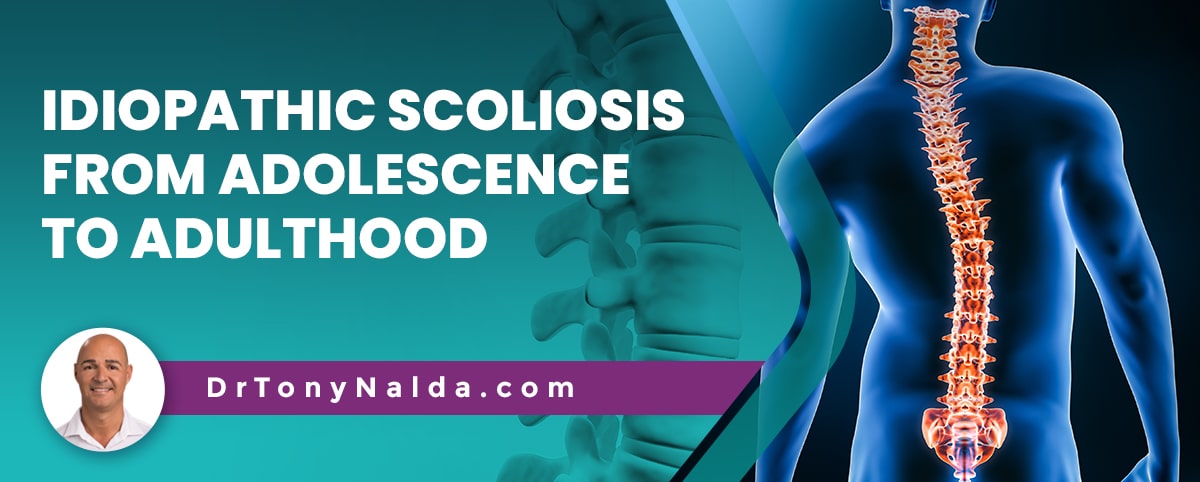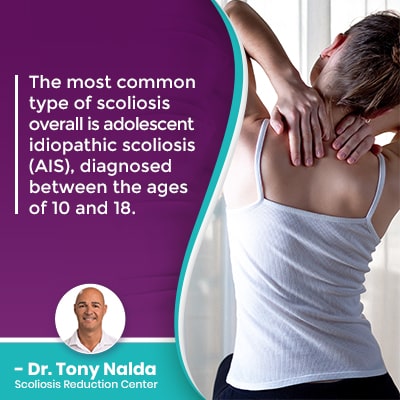Idiopathic Scoliosis From Adolescence To Adulthood

Not only does scoliosis range widely in severity from mild to moderate and severe to very severe, there are also multiple different condition-types, each with its own characteristics and treatment needs. When known, a condition's cause has to be addressed, as this is the difference between merely addressing symptoms of a condition, or the condition itself.
Idiopathic scoliosis is the most common type to affect all ages. Idiopathic means cause unknown, and while we don't fully understand what causes its initial onset, we know what triggers its progression: growth. So there is a different focus in treating idiopathic scoliosis in children versus adults.
Scoliosis is most commonly diagnosed during adolescence, but it affects all ages, so let's start with the different severity levels and types of scoliosis.
Table of Contents
Classifying Scoliosis
Part of diagnosing scoliosis involves further classifying conditions based on specific patient/condition variables; this is done to streamline the treatment process, and also to inform the crafting of customized treatment plans.
In order to reach a diagnosis of scoliosis, an unnatural sideways spinal curve, with rotation, and a minimum Cobb angle measurement of at least 10 degrees has to be present.
Scoliosis is diagnosed through a combined physical examination that involves taking the patient's medical/family history, and X-ray results to fully see what's happening in and around the spine, and to confirm a patient's Cobb angle.
Cobb angle is known as the gold standard when it comes to diagnosing and assessing scoliosis; it's determined during X-ray by drawing lines from the tops and bottoms of the curve's most-tilted vertebrae, and the resulting angle is expressed in degrees.
The more severe a patient's scoliosis, the more complex it is to treat, and the more likely it is to continue progressing and cause noticeable symptoms.
The higher a patient's Cobb angle, the further out of alignment the spine is, and this means introducing uneven forces to the spine, its surrounding muscles, nerves, and the rest of the body.
- Mild scoliosis: Cobb angle measurement of between 10 and 25 degrees
- Moderate scoliosis: Cobb angle measurement of between 25 and 40 degrees
- Severe scoliosis: Cobb angle measurement of 40+ degrees
- Very-severe scoliosis: Cobb angle measurement of 80+ degrees
In addition to condition severity, patient age, and curvature location, condition type is important, and this is determined by causation, and the most common type is idiopathic scoliosis.
What is Idiopathic Scoliosis?
Idiopathic means not clearly associated with a single-known cause, but this isn't the same as saying there is a complete absence of a cause; instead, idiopathic scoliosis is considered to be multifactorial.
 Conditions that are multifactorial can have a number of different causes, or a combination of causes, that vary from person to person.
Conditions that are multifactorial can have a number of different causes, or a combination of causes, that vary from person to person.
Idiopathic scoliosis is the most common type to affect all ages. Idiopathic scoliosis accounts for approximately 80 percent of known diagnosed cases, and the remaining 20 percent are associated with known causes: neuromuscular scoliosis, degenerative scoliosis, and congenital scoliosis.
Neuromuscular scoliosis is caused by the presence of a neuromuscular condition such as cerebral palsy, spina bifida, or muscular dystrophy.
Degenerative scoliosis is caused by natural age-related spinal degeneration, and congenital scoliosis is caused by a malformed spine that develops in utero, so babies are born with the condition.
The most common type of scoliosis overall is adolescent idiopathic scoliosis (AIS), diagnosed between the ages of 10 and 18.
So let's discuss the specific differences between idiopathic scoliosis in adolescents versus adults.
Adolescent Idiopathic Scoliosis
Adolescents diagnosed with scoliosis are at risk for rapid-phase progression because the main trigger for progression is growth, and the stage of puberty is characterized by rapid and unpredictable growth spurts.
As a progressive condition, scoliosis has it in its nature to worsen over time, and this means that where a condition is at the time of diagnosis doesn't mean that's where it will stay.
Mild untreated idiopathic scoliosis can progress to moderate idiopathic scoliosis, severe idiopathic scoliosis, and very-severe scoliosis.
So when treating adolescent idiopathic scoliosis, the goal is to reduce the scoliotic curve on a structural level, and this is worked towards through condition-specific chiropractic care that involves a series of techniques and manual adjustments applied to adjust the position of the curve's most-tilted vertebrae.
When successful, chiropractic care can help realign the spine, and this means restoring as much of its healthy curves as possible because when an unhealthy curve develops, it doesn't just affect the spine where it's developed, but can disrupt the biomechanics of the entire spine.
So when treating idiopathic scoliosis in adolescents, the focus is on achieving a significant curvature reduction and holding it there throughout growth; this is working towards counteracting the condition's progressive nature.
Once I start to see structural results in the form of a curvature reduction, I can shift the focus to helping adolescents increase their core strength as this means the spine is getting better support from its surrounding muscles.
Physical therapy and condition-specific exercises can help augment corrective treatment results through increasing strength and flexibility, making the spine more responsive to treatment, addressing any related muscle imbalance, improving posture, and activating certain areas of the brain for improved brain-body communication.
Corrective bracing can be particularly effective on growing spines, so is often a regular facet of adolescent idiopathic scoliosis treatment, and the final and ongoing phase is rehabilitation, and this involves performing custom-prescribed home exercises to further stabilize and heal the spine.
Now, when treating idiopathic scoliosis in adults, the focus is different.
Idiopathic Scoliosis in Adulthood
When it comes to idiopathic scoliosis in adults, this is the most common type, and idiopathic scoliosis diagnosed in adults are cases of adolescent idiopathic scoliosis that went undiagnosed and untreated during adolescence.
 It's quite common for adolescents to live with scoliosis for years unaware, and especially when mild as postural changes can be subtle, and as scoliosis doesn't become a compressive condition until skeletal maturity has been reached, it's not commonly painful in children.
It's quite common for adolescents to live with scoliosis for years unaware, and especially when mild as postural changes can be subtle, and as scoliosis doesn't become a compressive condition until skeletal maturity has been reached, it's not commonly painful in children.
In adults, the spine has stopped growing, so it's no longer experiencing the constant lengthening motion of a growing spine, and that's what counteracts the compressive force of the unnatural spinal curve in children; it's compression of the spine and its surrounding muscles and nerves that causes the majority of condition-related pain.
In fact, it's most often back pain, and more so pain that radiates into the extremities, that brings adults in to see me for a diagnosis and treatment.
Adults do also experience postural changes such as a prominent lean to one side, but the main symptom is pain, and age-related spinal degeneration also contributes to spinal instability.
After idiopathic scoliosis, degenerative scoliosis is the next most common type to affect adults.
So when treating idiopathic scoliosis in adults, the focus on monitoring for progression isn't as urgent because the progressive trigger of growth has been removed, but all types are progressive scoliosis, and because of age-related spinal degeneration, the actual rate of scoliosis increases with age.
The focus of treating idiopathic scoliosis in adults is also to achieve a curvature reduction, but more so to reduce it back to where it was prior to becoming painful and symptomatic.
Increasing core strength is also a focus, but it's more about stabilizing the spine, and corrective bracing is used more for short-term pain management and stabilization than augmenting corrective results, and rehabilitation also involves home exercises and continued chiropractic care to further stabilize the spine.
Conclusion
So when it comes to idiopathic scoliosis from adolescence to adulthood, it's not uncommon for patients to be unaware of their AIS until the condition has progressed, with time and growth, into adulthood.
Once skeletal maturity has been reached, the condition tends to become painful, and while pain is unpleasant, it does tell us when something wrong is happening inside the body, and this is why many adult patients' journey with idiopathic scoliosis starts in adolescence.
As a progressive condition, when treatment is started can be almost as important as the type of treatment started, and particularly when treating idiopathic scoliosis in children, being proactive is key.
Here at the Scoliosis Reduction Center, I treat patients of all ages, and while there are never treatment guarantees, with an early diagnosis and proactive treatment, many patients with idiopathic scoliosis can be treated successfully without the need for invasive spine surgery.
Scoliosis progresses at different rates, but idiopathic scoliosis in adolescents is likely to progress far faster than idiopathic scoliosis in adults because most cases of idiopathic scoliosis in adults have been experiencing progression since adolescence.
The most important thing to understand about a diagnosis of adolescent idiopathic scoliosis is that if left untreated, or not treated proactively, it's likely to get worse and progress into adulthood, at which point, scoliosis curves are going to be more complex to treat.
Regardless of severity or age, however, the best time to start treating scoliosis is always now.
Dr. Tony Nalda
DOCTOR OF CHIROPRACTIC
After receiving an undergraduate degree in psychology and his Doctorate of Chiropractic from Life University, Dr. Nalda settled in Celebration, Florida and proceeded to build one of Central Florida’s most successful chiropractic clinics.
His experience with patients suffering from scoliosis, and the confusion and frustration they faced, led him to seek a specialty in scoliosis care. In 2006 he completed his Intensive Care Certification from CLEAR Institute, a leading scoliosis educational and certification center.
About Dr. Tony Nalda
 Ready to explore scoliosis treatment? Contact Us Now
Ready to explore scoliosis treatment? Contact Us Now





